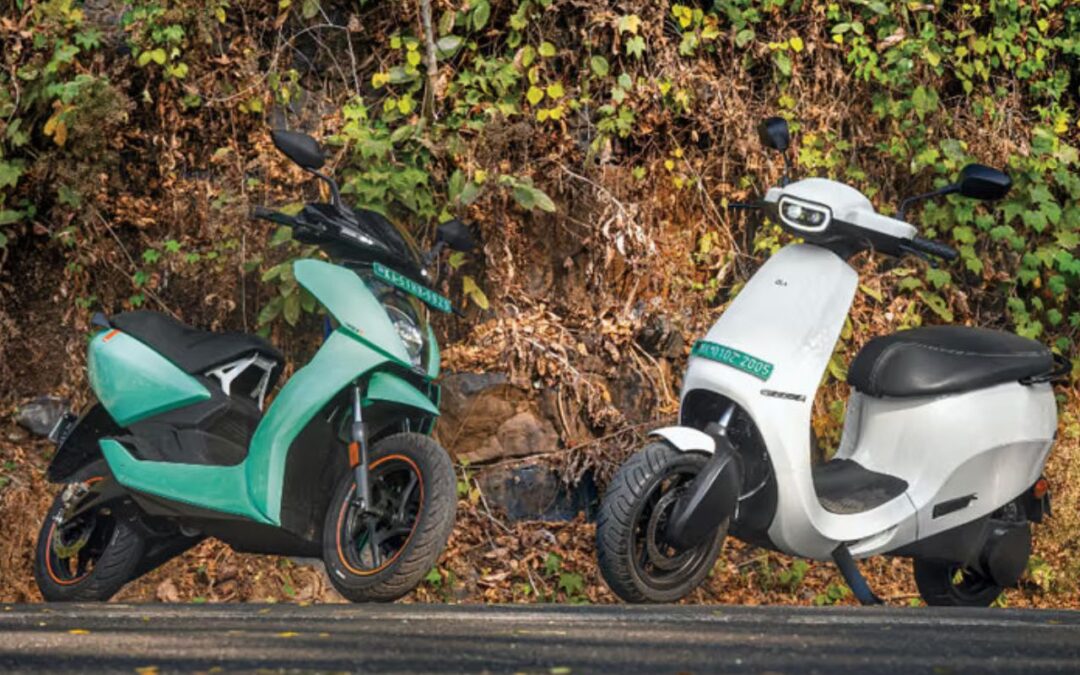Synopsis- This article compares Ola Electric and Ather Energy’s electric scooters in 2025, looking at range, performance, tech, pricing, and reliability. Ola provides more overall value and more features, while Ather provides better build quality and after-sales support. The smarter choice will depend on your use case and service needs.
India’s electric scooter market is booming in 2025, thanks to rising fuel prices, environmentally conscious buyers, and the demand for smart mobility. Ola Electric and Ather Energy have positioned themselves as technology-led electric scooter businesses. Their scooters come with both incredible design and outstanding specs. They may meet different needs, as these two brands represent very different priorities. This article compares their range, technology, pricing, and reliability for the current models to see which brand represents the smarter buy this year.
Brand Overview & Flagship Models
- Ola Electric has shaken up the marketplace with its outrageous designs, aggressive pricing, and vision for opening locations all over the country. Their S1 Air and S1 Pro Gen 3 scooters are long-range scooters that have amazing dashboards (and all the features) for mass-market consumers requiring style and performance.
- Ather Energy is known for refined engineering, consistent software, and premium build quality. Their top models—the 450X, 450 Apex, and Rizta Z—are meant for urban riders who need not just reliability but also safety and tech functionality.
Performance & Real-World Range
- The Ola S1 Pro Gen 3, which has a 4-kWh battery, boasts a 195 km IDC range and a real-world 150 km, top speed of ~120 km/h, and rapid acceleration, is designed for power riders and highway riding.
- The Ather 450X and 450 Apex, running a 3.7 kWh battery, have an IDC range of ~157 km and a real-world range of 110–120 km, and a top speed of ~100 km/h. In terms of throttle control, traction stability, and predictable handling, it’s fair to say Ather has a strong advantage for inner-city riding.
- However, both companies offer several ride modes, regenerative braking, and similar charge times (4 to 6 hours). Ola is a little faster, while Ather has better refinement and control.
Smart Features & Technology
- The Ola Electric, powered by MoveOS 4, has cruise control, party mode, voice commands, proximity unlock and keyless entry, and a 7-inch TFT screen with smartphone integration. It is one of the most heavily featured OS platforms in this category.
- Ather Energy, using its AtherStack 6, focuses on useful tech like Google Maps, MagicTwist regenerative braking, multiple traction modes, FallSafe, AutoHold, Park Assist, and notifications from WhatsApp. Ather’s paid Pro Pack provides access to everything.
- While the Ola has a longer list of features, the Ather is smoother and more reliable, catering to those who value software stability over features.
Design, Comfort & Build Quality
- Ather scooters showcase a sporty, minimalist design, with a robust chassis and nimble handling, perfect for urban riders. The exceptionally high fit & finish quality of materials provides a premium, refined feel.
- Ola scooters focus on comfort and utility with wider seats, larger footboards, and the class-leading 34L under-seat storage, to cater for families & day trips.
- Ola scooters are better in terms of space and practicality, while Ather scooters outperform in consistent build quality and ride refinement for riders who appreciate the quality of build.
Pricing & Value for Money
| Model | Approx. Price |
|---|---|
| Ola S1 Air | ₹90,000 |
| Ola S1 Pro Gen 3 | ₹1.35 lakh |
| Ather Rizta Z | ₹1.10 lakh |
| Ather 450X | ₹1.50 lakh |
| Ather 450 Apex | ₹2.00 lakh |
Ola delivers better value with more range and features per rupee. Ather, while more expensive, has premium build quality, reliability in the long term, polished software, and overall user experience, which may be preferable for those who want easy, smoother ownership experience without worry.
Also read: Top 6 Superbikes in India for 2025 – Ultimate Machines for Speed Lovers
Charging Network & After-Sales Support
- Ola has built a Hypercharger network with 6,000+ stations and rapid charging (~50 km in 15 minutes), but its after-sales service has been criticised for delays and inconsistencies. Ola has introduced “Hyperservice” to improve after-sales service and hopes to achieve 1,000 service centres by the end of FY 2025.
- In contrast, Ather Grid is India’s most reliable two-wheeler EV charging network, known for its high uptime and availability within urban settings. Ather’s after-sales service also scores very well on transparency, responsiveness, and reliability.
Reliability & Long-Term Ownership
- Ather has developed a “buy and forget” reputation, few complaints, OTA updates every 3 months, and success in long-term reliability. Post-sales experience contributes to its reputation in the industry.
- Ola is speeding but still struggles with last-minute software bugs and quality-control issues. Both companies have a two-year warranty, reliability, and lower downtime provides peace of mind for long-term ownership of an EV.
Final Verdict: Which Should You Buy?
Choose Ola Electric if you want the most range, the latest features, and a killer price – great for tech-savvy commuters and long-distance rides. Choose Ather Energy for a smooth, reliable, maintenance-free ride with great service – perfect for everyday city riding and worry-free ownership and riding. Both are excellent vehicles. The smartest buy depends on your personal use, price point and local service access.
Written by N G Sai Rohith





